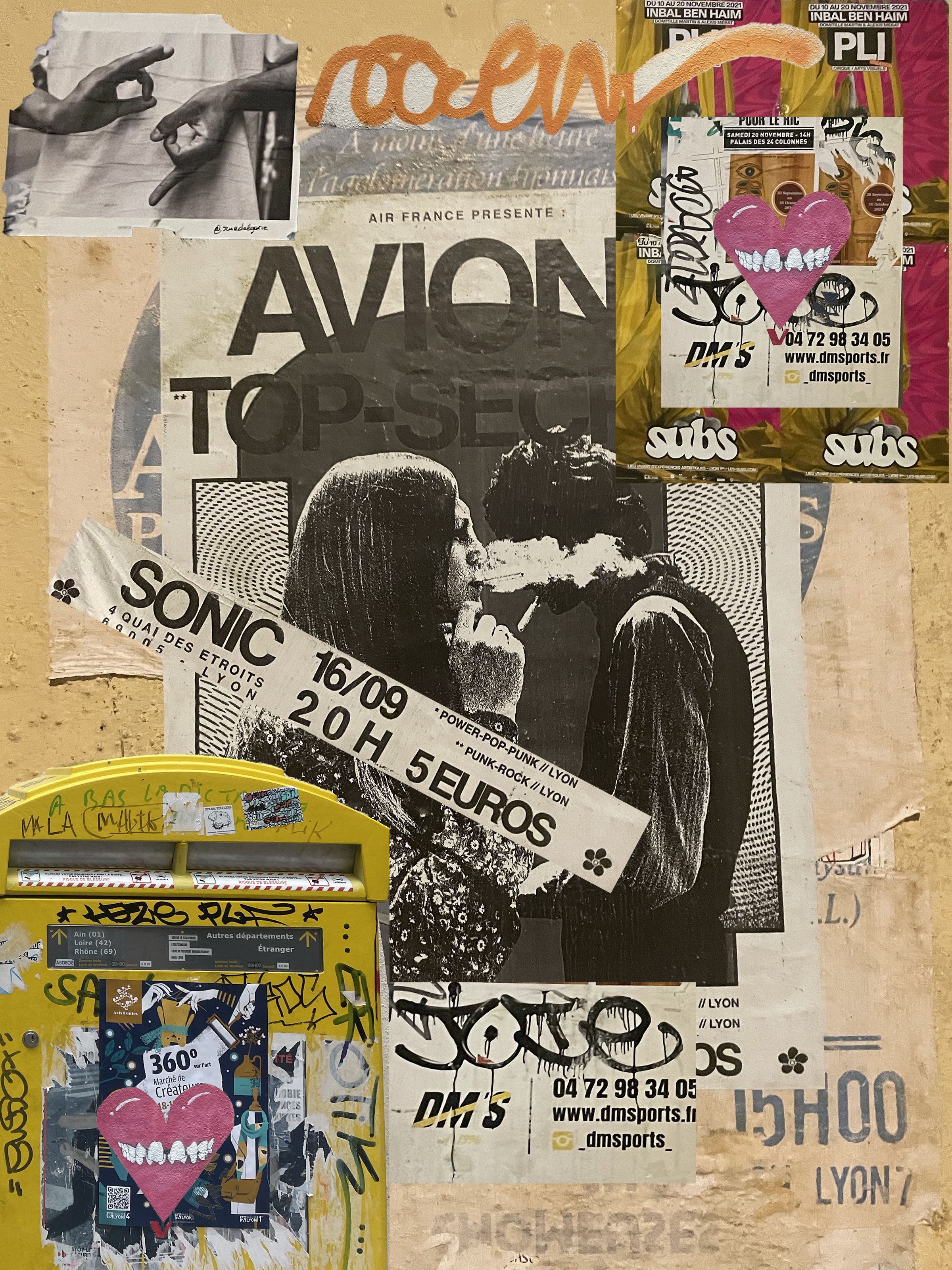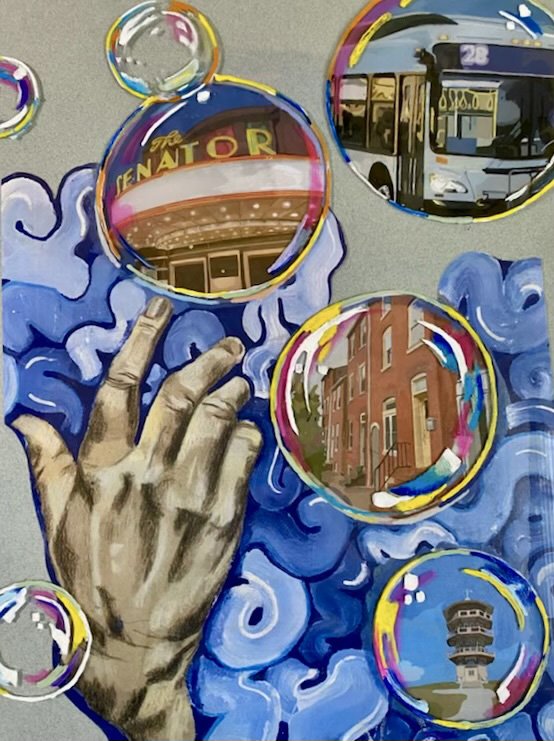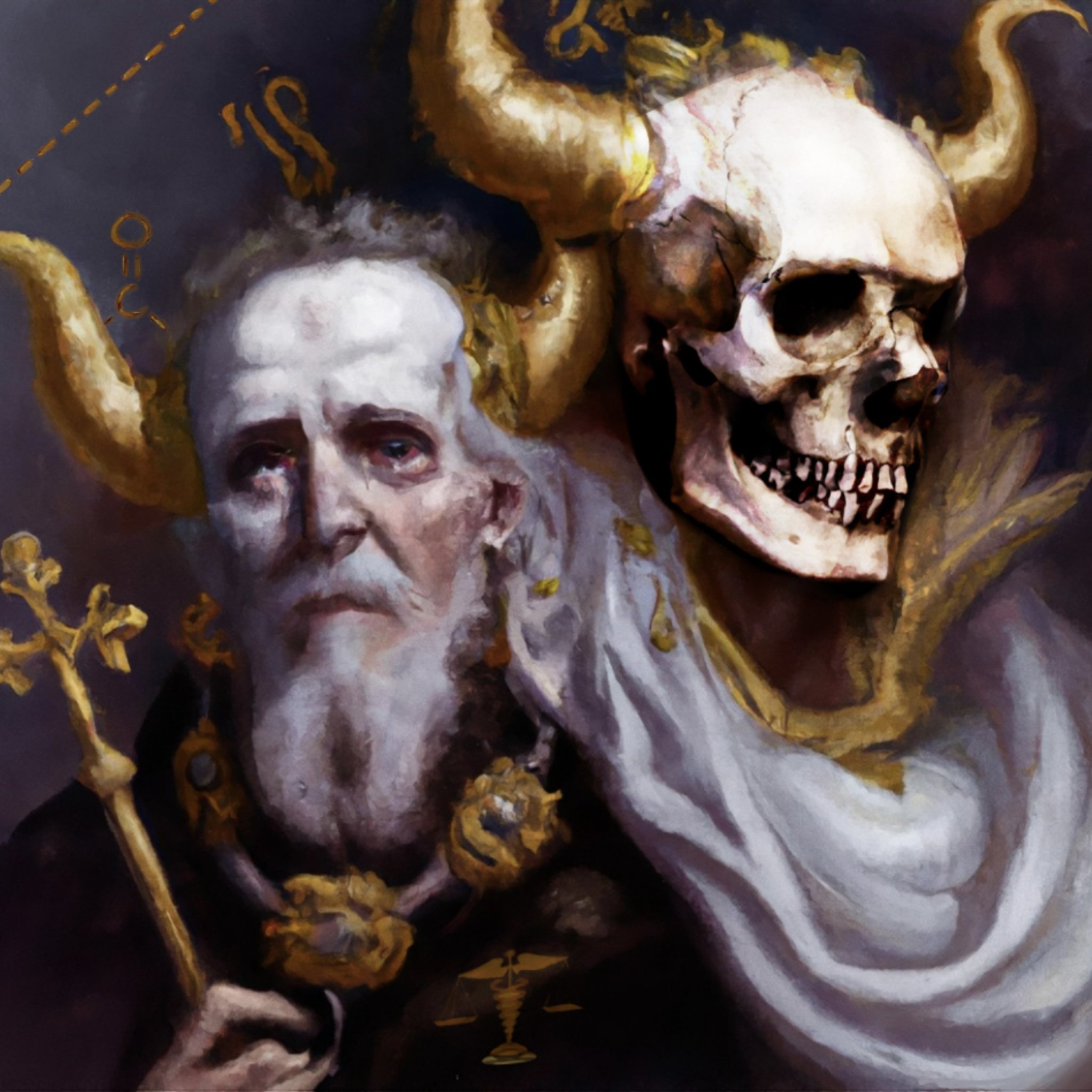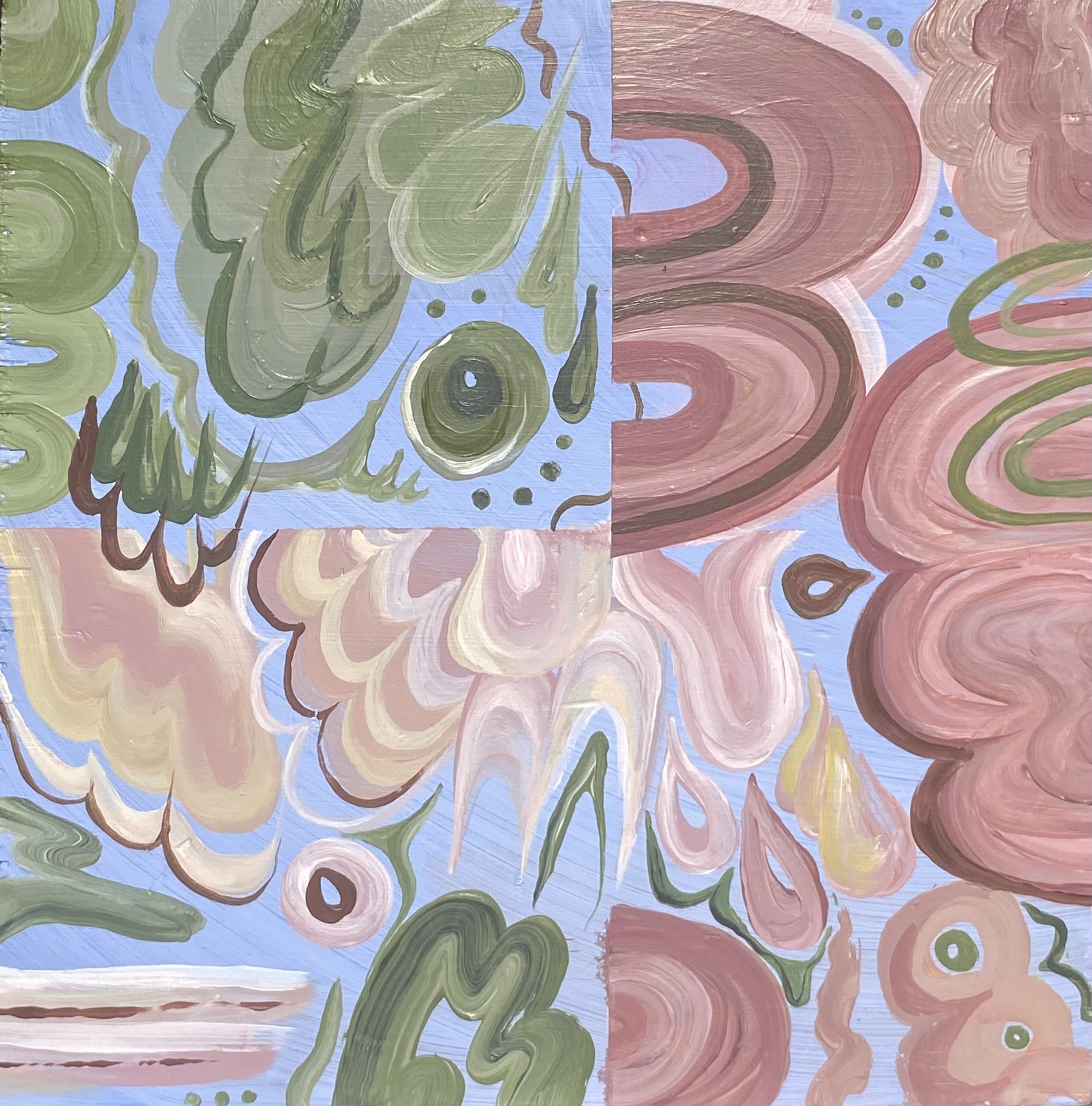Through the Looking Glass of “Prisms”
Our current exhibition at the Julio Fine Arts Gallery is titled Prisms. The bodies of artwork reflect the different narratives of the artists whose work is exhibited through the capstone course, Professional Practices. Billy Friebele, the professor of the course, titled the show “Prisms.” Friebele states, “The title Prisms refers to the way that the artists in this class work in a diverse array of mediums and with a wide spectrum of topics stemming from a common shared experience of working in the same studio as a creative community. Each body of work is in fact a prismatic expression of the students' studies, research, and material experiments influenced by coursework both within and outside of the Visual & Performing Art Department.” Prisms visually embodied each student’s interests, interdisciplinary studies, and inspirations. The artwork ranges from clay sculpture, digital painting, collage, photography, and much more.
Randi Little
Little’s project, “Creative Histories: Using Public Art As A Tool for Community Engagement'' expands on the question posed by her Design Thinking and Innovative Solutions Course, “How might we weave an honest account of the diverse history of Loyola into the campus experience and highlight stories of the people who have made Loyola what it is today?” Little’s solution is to create an interactive public art walk that images Loyola's past, present, and future. Little will collaborate with Dr. Carey and Dr. Zimmerelli’s Aperio Project. The project explores Loyloa’s relationship with slavery. Participating students produced historical accounts of the topic through different genres and perspectives. These histories will be translated into a monograph which will be at the center of inspiration for each piece in the art walk. The individual pieces will be painted and designed by Loyola’s Art Association. Little will also create QR codes that will provide the viewer with a virtual and interactive experience. In the gallery is a bulletin board explaining and visualizing the process. Little’s goal is to use the interactive art walk as a visual tool to engage with Loyola’s past and current environments.
Laura Yacoubi
My work is a series of collages that consist of two mixed media pieces, one print, and one sculpture. My inspiration for my work comes from the culmination of experiences which derive from the urban space. I began thinking about the ways our experiences in diverse spaces can cater to individuality, allowing us to learn about ourselves, our interests, and the different ways we can learn and grow. I realized how different each space is and how these differences contain multitudes of identity. I was inspired by collage artist Romare Bearden, for his unique ability to capture the feeling of urban spaces through the fragmentation and assemblage of images. The reworking, remixing, and assembling of ideas and images, and magazine cut-outs allows me to recontextualize the modern world through the lens of my interpersonal experiences throughout the course of my life. Through collage and assemblage, I strive to capture and emphasize the essence of the city, intricate spaces, and the culmination of experiences to create artwork that expresses the importance of human connection and individuality.
Sadie Applegate
Applegate’s work, Living With an Orchid shows the different parts of the flower and how it can be used as a metaphor to represent herself. Through digital, acrylic, and watercolor painting, she studied herself as an artist and as in individual. Applegate has always been interested in botanicals due to growing up around plants in her grandmother’s flower shop. To create her artwork, Applegate purchased an orchid and placed it in her studio to use as inspiration. She began realizing that she and the flower were growing together. Applegate was particularly inspired by the parts of the plant that don’t get as much attention and used this new perspective as a mode of creation. She began relating to the planting in new ways. Applegate also studied the human body in comparison to her plant drawings. The different parts of the human body and the orchid are fragmented to form and represent Applegate as she exists in both our digital and concrete world. In Living With an Orchid, Applegate represents the orchid in its entirety, even the parts that we don't necessarily consider “beautiful.” By doing this, Applegate is simultaneously representing herself through the perspective of beauty and value.
Siobhan McGeever
McGeever’s inspiration stems from a summer of babysitting. She wanted to capture and recreate the innocence and wild imagination found in children. She was also inspired by her interdisciplinary study in psychology, particularly the Adolescent Development and Psychology course. The artwork she has created for this exhibition embodies her personal reflection on the stages of life. Through acrylic and digital painting, McGeever captures stages of life and memories displayed in bubbles. Each frame of work is categorized by a specific age range with a fixation. These fixations range from worries of aging, to insecurities and explorations of identity. The drawings in the background coincide with the individual’s personality, identity, and things they’re experiencing during that time. As an example, McGeever states, “In the first piece the child’s perspective is demonstrated with a tree in the background to hint at the fact that the individual is at the start of their life. These are their roots to their life, which from an adolescent development perspective is so essential to how the child will cognitively grow.” These memories and stages of life extended into a larger scope in the understanding of an individual's perspective through self-reflection and understanding of identity.
Brooke Scotti
In combining her interdisciplinary studies of biology and studio art, Brooke Scotti’s inspiration comes from working in a histology lab where she and a pathologist surgically removed tissue from the body to conduct medical diagnoses. Scotti uses gouache on watercolor and plexiglass to make her research come to life. She used color to dye slides to distinguish different sections of tissue. She realized this process visually created abstract patterns and designs, which interested her artistically. As a part of her installation, there is a microscope with a painted slide so the viewer can see what she saw in the laboratory. Even though Scotti is observing tissue from a microscope with a sense of detachment, she understands and feels empathy for the patients and their health. She printed two “HOW TO” guides. This list is an excerpt from Bernie S. Seigel’s book Peace, Love, and Healing. Seigel discusses the exploration of self-healing as well as body-mind communication. He found this list within In Surviving and Thriving with AIDS: Hints for the Newly Diagnosed, from the New York People With AIDS Coalition. One is satirical and explains the different ways a person can get sick. The other provides a guide on how to live well. “Not taking care of yourself and your health can hinder your future. The most important thing in life is your health,” Scotti explains. The other guide is how to live well. It explains how you can create and maintain a happy and healthy lifestyle. Through the creation of her installation, Scotti reveals the beauty behind a diagnosis and the connection with a stranger.
Lia O’Riordan
For this exhibition, Irish artist Lia O’Riordan creates digital and acrylic observation paintings to contrast the worlds of religion and science. O’Riordan was inspired by her past art history and theology classes. She was also inspired by Hilma Af Klint that contains multitudes of geometry and spirituality. She was fascinated by the religious paintings of the Renaissance and the discoveries made during the scientific revolution. She recognized the different ways the two overlapped. An example is the digital painting of Demeter, the Greek Goddess of agriculture with a modern day farm. When viewing the piece, you can see how the two create a paradox. “There’s a detachment between the spiritual and science today and that detachment, some philosophers say, is the cause of people and cultures treating the environment so terribly. I tried to depict this in my most recent pieces with the contrast between modern technologies and the “old ways” of pagan and polytheistic religions.” In her installation, O’Riordan has two acrylic paintings and six digital paintings that convey the contrast of science and religion as they relate to our current environment.
Evan Casas
Artist Evan Casas creates work that deals with the human body. Specifically, distorting human anatomy, particularly the face. “In the human body, everything has a purpose, and every curve or indent leads to something else. This aspect leads me to draw faces and bodies as if they were flowing streams where each line interacts and plays off other lines. I focus on this because I feel very aware of my body. I see bodies as clothes or "Meat Suits" that encase our being and give outward clues to our personalities. This belief isn’t one of religion but of a separation of the conscious and subconscious.” Casas’ work confronts the viewer and asks us to think of the human body in new ways. In his installation, Casas uses clay to move from the flat 2D space into a 3D space that captures the body and its existence. His work allows you to see everyone else through different eyes, highlighting the notion that bodies contain multitudes.
Madelyn Chelak
While viewing her artwork, Chelak asks us to reflect and meditate for a moment to create a sensation of peace, even if it’s only for a few minutes. “When we measure success, it is based on our productivity rather than enjoyment. Time spent wisely is time spent working and working quickly. This mentality makes us desensitized to the simple pleasures that allow ourselves to feel a sense of peace and content.” By using mixed mediums and digital and acrylic paintings, Chelak created designs and patterns that allowed her to enter into a peaceful state of mind. This practice allows her to appreciate the mundane. Chelak was also inspired by Dr. Davis’ Asian Thought philosophy course that allows students to understand and experience the importance of mediation. This state of mind allows us to get lost in the activity we’re doing which ultimately creates a form of euphoria. This is what painting is truly about- finding joy and peace, while learning about yourself and ignoring the busy world around us. “In a digital age where technology is constantly competing for our attention, I ask you to do nothing besides stare into my work.” Chelak asks the viewer to challenge their preconceived notions of “doing nothing” and contemplate why they are negative.
Greyson Pearce
Greyson Pearce creates hybrid photographs, images, videos and sounds, to capture the relationships created by combining old photographic techniques like wet-plate collodion tin-types with new ones such as artificial intelligence. With an interest in photography, Pearce’s work explores photography as both a conventional and unconventional mode of art. Pearce explains that when photography was first used and discovered, it became controversial, as it could replace classic art forms such as drawing and painting. He compares and contrasts this by using art forms that are considered unconventional today such as graffiti and artificial intelligence and combines with traditional and old school forms of photography. Through multi-media works, Pearce demonstrates the intersection of old and new art forms and how they can coexist together to create new possibilities and meanings.
Featuring Loyola Maryland Seniors: Randi Little | Laura Yacoubi | Sadie Applegate | Evan Casas| Siobhan McGeever| Brooke Scotti | Lia O’Riordan | Madelyn Chelak | Greyson Pearce |
Come see the wonderful artwork created by your hardworking peers!
The exhibition will run from Thursday, December 1st through Sunday, December 17th.
To learn more about the Gallery’s programs, current and past exhibitions visit julioartgallery.com or call 410-617-2799. Follow us on social media @JulioArtGallery for updates!
Randi Little, Creative Histories: using Public Art as a Tool for Engagement, 2022
Laura Yacoubi, Place de Terreaux #2 Joyeux Anniversaire, 2022
Sadie Applegate, Living with an Orchid (Leaves), Digital Drawing, 2022
Siobhan McGeever, Baltimore, Acrylic & Digital on Glass 2022
Brooke Scotti, Slice of Being Total Thyroid Lobectectomy. Removal of one of two thyroid lobes, leaving the other intact. This surgery may be performed if there are nodules that cause symptoms or could be cancerous. Also used to treat excessive hormone production, Gouache on Watercolor Paper, 2022
Lia O’Riordan, ars mortis, Thanatos and Hades - Greek, Digital painting 2022
Evan Casas, Decay, Clay, 2022
Madelyn Chelak, Self Help pt.2, Acrylic on Wood, 2022
Greyson Pearce, Analog Dance Music, Wet-Plate Collodion Tintype 2022








